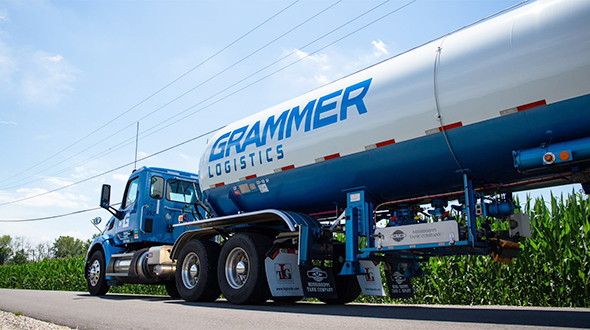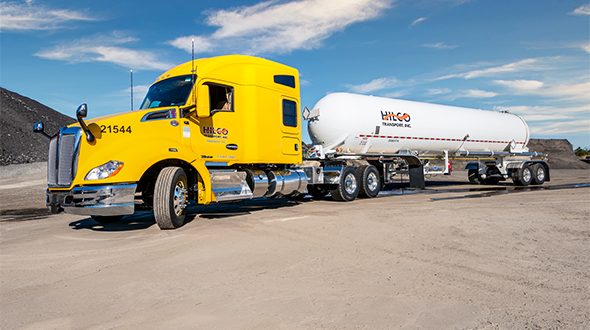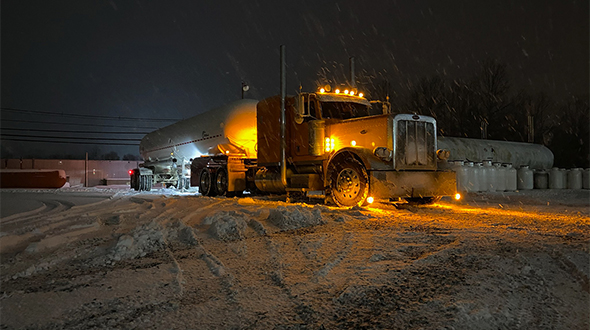Common carriers mull solutions to challenging driver environment
Patrick Maher admits to the cliché, but the chief commercial officer at Grammer Logistics views trucking challenges this way: We’re all in this together.
That means it’s important for common carriers in the industry to hold conversations with their customers – propane marketers or other natural gas liquid (NGL) suppliers – about the business environment in which they’re working, pertaining to driver shortages and rising wages, or about kinks in the supply chain.

Grammer Logistics covers territory east of the Mississippi River, plus Texas and Louisiana. (Photo courtesy of Grammer Logistics)
Companies can share the messages formed in these conversations, Maher says, where a common understanding among all can help the industry maintain and ultimately increase its capacity to serve customers.
“Trucking companies need ongoing support from their customers,” he says. “If communication breaks down, we stand a great chance of losing those drivers to other modes of transportation, and risk not having the trucks where and when our customers need them.”
Grammer Logistics and other common carriers in the industry have witnessed a shift on the driver side of their businesses. Employees seeking driving jobs today have more choices in where they work, the schedules they follow and the pay they earn. It’s forcing carriers to adjust their operations, in some cases becoming more proactive in how they work with drivers or rethinking strategies on how to find and retain them.
Maher describes how bulk tanker drivers hauling LPG or other chemicals historically have received higher pay than drivers who haul regular freight, but those moving freight “are pushing right up against us” and forcing the industry to raise its pay in order to compete. A December fact sheet from the White House notes how wages for drivers in all trucking segments have increased 7 percent to 12 percent in the last year alone.
“Drivers have choices. They can work for a lot of different companies – grocery stores, retail, Amazon – that do not require the same certifications and risk associated with hauling hazardous materials,” Maher says. “That’s an industrywide issue.”
Adds Jon Long, president of North Carolina-based Hilco Transport, “This was happening before, but you didn’t feel it as much – and the pandemic put it on steroids.”
‘The best of the best’

Hilco Transport has purchased more equipment to meet demand while attracting a higher driver count. (Photo courtesy of Color and Chrome Photography)
Long cites the inconsistent nature of the LPG transportation business and the hazmat endorsement requirements as factors that should place the industry’s transport drivers higher on the pay scale compared to other industries. The fact that regular freight haulers are earning similar pay working year-round creates a problem for the entire hazardous bulk transportation industry.
Though Long admits to the struggle, he says Hilco is working hard to address the issues.
The company has purchased more equipment – adding 30 new trailers to its tanker division fleet of about 150 – to meet the higher demand while attracting and retaining a higher driver count than in previous winters. It employs about 250 drivers in the division.
“In my opinion,” Long says, “adjustments will be needed to offset the cost that’s coming through the organization from a driver pay standpoint, to an efficiency standpoint, to an equipment standpoint where you need more equipment to generate the same amount of revenue. That’s trucking in general today.”
Henry Papiano, president of New Jersey-based C Three Logistics and a veteran of the transportation industry, says the trends were an eye-opener for him.
He recalls hazmat haulers of years past as having the elite, top-paid drivers in the industry because, like today, they are subject to extensive background checks and driver training requirements.
“When people come to work and haul for propane, this is a job where you’ll retire at,” he says. “People had to earn the right to do what we do. There’s been a shift in culture.”

New Jersey-based C Three Logistics raised wages 12 percent for drivers during the pandemic. (Photo by Henry Papiano)
Papiano says the demand and wages have increased for drivers hauling cardboard boxes, produce or other flatbed items, and drivers can receive significant sign-on bonuses for filling these positions.
“It’s been a strain on people like myself trying to bring people on,” says Papiano, whose company hauls propane and butane in a fleet of about 140 trailers.
Still, his perception of C Three’s propane drivers hasn’t wavered. He feels fortunate that 90 percent of them “are seasoned in this business,” performing the high level of work that’s required in the industry.
“A propane driver has to be the best of the best. Our drivers are the most trained, experienced, better on the road for what we do,” says Papiano, who raised wages 12 percent during the pandemic but adds the business environment gets more difficult every day.
Uncovering solutions
Indiana-based Grammer Logistics says it wants to get ahead of the driver situation, invest in its people and grow for the sake of its customers by adding more capacity and flexibility. It also wants to change the perception of the bulk fuels driver.
“We are choosing to be proactive versus allowing the market dictate to us what’s going to happen,” Maher says.
In response, Grammer stepped up its recruiting efforts; hired a manager of integration to shadow drivers for their first 90 days and ensure they’re getting everything they need; and initiated a lead driver program where top drivers per region talk to their colleagues about their positions.
“Anything we can do to keep the driver satisfied,” says Angela Branchi, senior vice president of the NGL division at Grammer Logistics. “Our retention numbers are very important to the company.”
Grammer’s growth in recent years has stemmed from the acquisitions of North Carolina-based Sterling Transport and Houston-based LiMarCo Logistics. The combined companies gave Grammer a more balanced portfolio as it expands in the NGL and chemical spaces, covering territory east of the Mississippi River, plus Texas and Louisiana. Also, in December, the company announced plans to open a new commercial sales office in Houston as it focuses on locating team members closer to its customers.
“We’re investing in people because we know it’s always a relationship business, whether with customers or drivers,” Maher explains. “We’re going to get out in front of this and have tighter relationships with the individual driver, with the individual customer.”
If the industry is going to find success in the challenging driver environment, Maher says, conversations will have to center on building plans “outside the box.” It’s an opportunity for everyone to work closer together because those who plan and partner will see better results.
“That may mean agreements look different in the future; that may mean pricing structures, routes look different,” he says. “The main issues surrounding supply chain and labor shortages are complex and do not appear to be going away anytime soon. In transportation, it’s always been a challenge.”
Clear communication between the transportation companies and their customers will form a foundation for long-term partnerships, Long says.
“Challenge your transport company to communicate on how they plan to service your account,” he says. “At the end of the day, we want to do a good job and we want to do it for a fair price. The only way to accomplish those things is to communicate.”
Over the last year and throughout the pandemic, Papiano says, the value of his employees has resonated with him because he realizes how important they are to the company.
“The better we can all just get back to appreciating one another we’re going to continue to make this industry successful and get back to our roots,” he says.
















